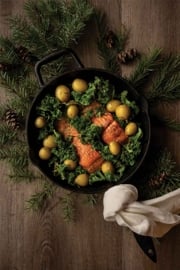Greens and Strawberry Salad with Chocolate Vinaigrette

This is one of those dishes you’ve got to try in order to believe. Chocolate adds new flavour notes to this entrée salad. The vinaigrette will solidify upon sitting, which can be rectified by whisking in some additional olive oil. Also consider adding toasted pecan halves.
1 lb (450 g) skinless, boneless, free-range chicken breast
3 cups (750 mL) baby spinach
2 cups (500 mL) arugula
2 cups (500 mL) strawberries, sliced
1 English cucumber, sliced
1/2 cup (125 mL) crumbled feta cheese
1/4 cup (60 mL) cocoa nibs
2 oz (57 g) dark chocolate
1/4 cup (60 mL) extra-virgin olive oil
1 1/2 Tbsp (22 mL) balsamic vinegar
2 tsp (10 mL) honey
1 tsp (5 mL) Dijon or grainy mustard
Pinch of dried chili flakes
Preheat oven to 350 F (180 C).
Place chicken on parchment or silicone-lined baking sheet and cook for 20 minutes, or until no longer pink inside and with an internal temperature of 165 F (74 C). Let cool and slice.
In large bowl toss together spinach, arugula, strawberries, cucumber, feta, cocoa nibs, and chicken.
Melt chocolate in double boiler or heatproof bowl set over saucepan of barely simmering water, stirring often until smooth.
With blender or food processor whirl together melted chocolate, olive oil, vinegar, honey, mustard, and chili flakes.
Divide salad among serving bowls and drizzle with chocolate vinaigrette.
Serves 4.
Each serving contains: 472 calories; 33 g protein; 28 g total fat (10 g sat. fat, 0 g trans fat); 24 g carbohydrates; 7 g fibre; 324 mg sodium
source: "Say Yes to Chocolate", alive #352, February 2012





